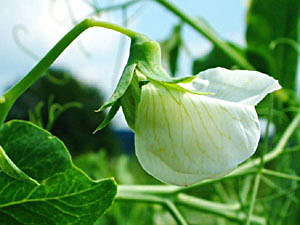
medicinal herbs
Garden Pea
Pisum sativum

Herb: Garden Pea
Latin name: Pisum sativum
Family: Leguminosae
Medicinal use of Garden Pea:
The seed is contraceptive, fungistatic and spermacidal. The dried and powdered seed has been used as a poultice on the skin where it has an appreciable affect on many types of skin complaint including acne. The oil from the seed, given once a month to women, has shown promise of preventing pregnancy by interfering with the working of progesterone. The oil inhibits endometrial development. In trials, the oil reduced pregnancy rate in women by 60% in a 2 year period and 50% reduction in male sperm count was achieved.Description of the plant:

Plant:
Annual
Height:
2 m(6 1/2 foot)

Flowering:
May toSeptember
Habitat of the herb:
Plants are not known in a genuinely wild condition.Edible parts of Garden Pea:
Immature seedpods - raw or cooked. The young seedpods have a sweet flavour, but there is only a thin layer of flesh with a fibrous layer beneath it. Immature seeds - raw or cooked. Sweet and delicious, they can be added to salads, or lightly cooked. A nutritional analysis is available. The mature seeds are rich in protein and can be cooked as a vegetable or added to soups etc. They can also be sprouted and added to salads, soups etc. The mature seed can also be dried and ground into a powder, then used to enrich the protein content of flour when making bread etc. The roasted seed is a coffee substitute. Leaves and young shoots - cooked and used as a potherb. The young shoots taste like fresh peas, they are exceptionally tender and can be used in salads.Propagation of the herb:
Pre-soak the seed for 24 hours in warm water and then sow in situ in succession from late winter until early summer. A minimum temperature of 10°C is required for germination, which should take place in about 7 - 10 days. The earlier sowings should be of suitably hardy varieties, the "round seeded", whilst later sowings can be of the tastier varieties, the "wrinkle seeded". By making fresh sowings every 3 weeks you will have a continuous supply of fresh young seeds from early summer until early autumn. If you want to grow the peas to maturity then the seed needs to be sown by the middle of spring. You may need to protect the seed from the ravages of mice. Another sowing can be made in middle to late autumn. This has to be timed according to the area where the plants are being grown. The idea is that the plants will make some growth in the autumn and be perhaps 15 - 20cm tall by the time the colder part of winter sets in. As long as the winter is not too severe, the plants should stand well and will grow away rapidly in the spring to produce an earlier crop. Make sure you choose a suitably hardy variety for this sowing.Cultivation of Garden Pea:
Plants are not known in a genuinely wild condition.Known hazards of Pisum sativum:
None knownPlant information taken from the Plants For A Future.
